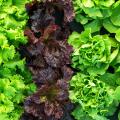Insecticides
Insecticides for the Home Vegetable Garden
Note: A complete list of insecticides for home vegetable gardens can be found on page 12 in the MSU Extension Service publication #1091 - The Garden Tabloid (PDF).
This section provides general information about commonly used garden insecticides. See the Insecticides for Home Vegetable Gardens table for specific pest/insecticide recommendations.
Use insecticides safely! Before using any insecticide, always be sure to read the label carefully and follow all label directions regarding personal protection equipment and instructions for mixing and applying the product. The label is the law, and the use directions it specifies are designed for the safety of the applicator, the environment, and those using the area. Handle insecticides with the respect they deserve. They are poisons, and excessive exposure can result in acute and/or chronic health problems.
Be sure the insecticide is labeled for use on the vegetable being treated. Few insecticides are labeled for use on every vegetable crop grown in the garden. Before applying an insecticide to a particular crop, be sure to read the label and verify that the product is labeled for use on that crop.
Observe and follow the pre-harvest interval. The pre-harvest interval, or PHI, is the amount of time that must elapse between making an insecticide application and harvesting the crop. PHIs vary greatly depending on the insecticide being used and the particular vegetable crop being treated. For example, the PHI for carbaryl (Sevin) is 3 days on tomatoes, 7 days on Irish potatoes, and 14 days on turnips. Failure to observe PHIs can result in consumption of excessive insecticide residues.
Specific Insecticides
(* indicates insecticides that are suitable for use in organic gardens.)
Carbaryl is most commonly sold under the brand name Sevin. This product has been a standard for insect control in the home vegetable garden for many years. It is effective against a wide range of pests and is labeled for use on most vegetables. It is especially useful against many beetles. However, this product does have a tendency to flare spider mites when used excessively.
Malathion is another long-time standard insecticide for home vegetable gardens. Like carbaryl, it controls a wide range of pests and is labeled for most vegetables. It is especially useful for control of aphids, “bugs,” and certain beetles.
Bt kurstaki*: Bacillus thuringiensis is a bacteria that produces compounds that are toxic to certain insect species. There are different species and strains of this bacteria that produce different toxins. Bt kurstaki produces a compound that is toxic to certain caterpillars but has no effect on other insect species. Thuricide is one of the more common brand names for this product. It is most effective against leaf-feeding caterpillars like loopers and diamondback moths.
Spinosad* is a relatively new microbial insecticide that is very effective against a number of different caterpillar pests. Two commonly available brand names that are labeled for use on many different vegetable crops are Green Light Spinosad Lawn and Garden Spray and Fertilome Bore, Bagworm, Leafminer, and Tent Caterpillar Spray. Spinosad is very effective against most caterpillar pests, but it is not effective against most other types of insects. However, it is also effective against thrips, leaf miners, and Colorado potato beetles. It is acceptable to use certain formulations of spinosad in organic gardens.
Insecticidal soaps* are potassium salts of fatty acids. They control insects that they contact by disrupting cell membranes. They are most effective against soft-bodied pests like aphids, mites, and thrips. Thorough coverage of the pest is necessary in order to achieve control.
Insecticidal soaps have a short pre-harvest interval and are labeled for use on most vegetables. Safer Insecticidal Soap is an example of one brand name.
Neem oil* is a botanical product that is primarily useful against aphids, mites, and whiteflies. It is labeled for use on most vegetables and is sold under several brand names (Monterey 70% Neem Oil is one example). Thorough coverage of the pest is necessary in order to obtain control.
Azadirachtin* is an organic product labeled for use on all vegetables, with a 0-day PHI. Azatrol is the brand name most often used by home gardeners, but several other commercial formulations are available. Azadirachtin has activity against a wide range of insect pests but is most useful against soft-bodied sucking pests, such as whiteflies and aphids. Although azadirachtin and neem oil both come from the seed of the neem tree, they are not the same product.
Pyrethrin* or pyrethrum is a botanical insecticide that is used primarily by organic gardeners. This insecticide provides rapid knockdown of most insects, but insects often recover. Piperonyl butoxide (PBO) often is mixed with pyrethrin to act as a synergist. This increases the overall effectiveness and helps prevent pests from recovering, but piperonyl butoxide is not acceptable for organic gardening. Pyrethrin or pyrethrin + PBO is active against a wide range of insects, is labeled for use on most vegetables, and has a very short pre-harvest interval. However, its efficacy is limited by its very short residual activity.
Acetamiprid has only recently been labeled for use in home vegetable gardens. It is especially effective against whiteflies and aphids and is labeled for control of many other pests. Ortho Max Flower, Fruit, and Vegetable Insect Killer is one common brand name. This product is sold as a ready-to-use spray and as a concentrate.
Pyrethroids are a group of relatively new synthetic insecticides that are modeled after the botanical pyrethrum molecule. These products are effective against a wide range of insect pests and are used at very low rates. The following pyrethroid insecticides are currently labeled for use in the home vegetable garden.
- Permethrin is one of the most useful insecticides for home vegetable gardeners. It can be used on a wide range of crops and controls a broad spectrum of pests. It also has shorter preharvest intervals than most other pyrethroid insecticides. Permethrin is readily available in most farm and garden stores and is sold under many different brand names (Bonide Eight Insect Control Concentrate, Hi-Yield Garden, Pet & Livestock Insect Control, and Martin’s Vegetables Plus are three examples). Permethrin is effective against many beetle, bug, and caterpillar pests, but it is not effective against whiteflies and spider mites.
- Bifenthrin is an especially useful pyrethroid on crops for which it is labeled, but bifenthrin is not labeled for all vegetable crops. Ortho Bug B Gon Insect Killer for Lawns and Gardens is a commonly available brand name. Bifenthrin is somewhat less likely than other pyrethroids to trigger outbreaks of spider mites and aphids.
- Lambda cyhalothrin is one of the newer pyrethroid insecticides (Spectracide Triazicide Insect Killer for Lawns and Landscapes is the most common brand name). It is very effective against a number of different insect pests, but it is labeled for use only on a very few vegetable crops.
- Esfenvalerate is one of the older pyrethroid insecticides. It is labeled for use on a number of different vegetable crops and controls a wide range of insect pests. Monterey Bug Buster II is one common brand name.
Applying Insecticides in Home Vegetable Gardens
You can choose from several different methods of applying insecticides to vegetables in your home garden. Liquid sprays, dusts, and ready-to-use sprays are three of the most common methods.
Dusts—A few insecticides are available for use as ready-to-use dust formulations (5% Sevin Dust and 0.25% permethrin are two examples). Dusts normally are applied using a shaker can—often the container the insecticide comes in is modified so it can be used as a shaker can—or a hand-powered, pump-type duster. Dusts have the advantage of being relatively convenient to apply, but they are generally less effective than sprays. It is also difficult to achieve thorough, uniform coverage with dusts, especially when using the shaker-can method of application. Also, many people consider dusts to be unsightly.
Ready-to-use sprays—Several insecticides are sold as ready-to-use, or RTU, sprays that are labeled for use in the home garden. Permethrin, carbaryl, cyhalothrin, cyfluthrin, and neem oil are examples of active ingredients that are sold as RTUs. These products come in hand-pump spray bottles in which the product has already been diluted to its final-use strength. These RTU treatments are a very convenient way to apply spot treatments to individual plants. However, they are too costly to use on a large scale.
Single-nozzle hand-pump sprayers—Single nozzle hand-pump sprayers are the most common method of applying insecticides in the home garden. They come in sizes ranging from 1 quart to 5 gallons, with 1 gallon being the most common size. They can be used to apply liquid concentrate, wettable powder, or wettable granule insecticides according to label directions. Here is an example of the directions that might appear on the label of a liquid concentrate: “Mix 1 tablespoon/ gallon of water and spray to runoff, taking care to direct spray to undersides of leaves.”
Hand-pump sprayers are powered by pumping air into the headspace over the insecticide mixture. This compressed air then forces the insecticide spray through the nozzle when the spray valve is opened. Most hand sprayers have a nozzle that can be used to adjust the coarseness or fineness of the spray droplets. Be sure to thoroughly rinse the sprayer after each use.
To avoid disappointing crop injury, it is strongly recommended that insecticides not be applied with a sprayer that has previously been used to apply herbicide. It is best to dedicate one sprayer specifically for herbicide use and another for applying insecticides and fungicides. Label each sprayer clearly.
Caution!
1. Be sure to read and follow all label directions.
2. Note and observe the pre-harvest interval (PHI).
3. Store insecticides in a safe, secure place where children cannot get to them.
4. If you spill any of the insecticide on your body, wash with soapy water immediately. Wash all exposed skin after dusting or spraying.
5. Wash all food before preparing or eating.
Publications
News
Vegetable producers across the Southeast are invited to the 2025 Vegetable Field Day on July 23 at the Mississippi State University station in Verona, Mississippi.
If you grow your own vegetables, you will likely see at least a few pesky insects that want to feed on your plants. Slugs are one of the pests you may be noticing now.
Did you know yellow squash is in the pumpkin family and are 95 percent water?




